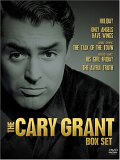Synopsis
Though they span a mere five years of his career, these are some of Cary Grant’s best films. They are also among the directors’ best films. Viewers wanting to see comedy from Hollywood’s Gold Age at its best and most sophisticated will be amply rewarded by spending a few evenings with this collection.
Holiday (1938) sees Grant engaged to the snobbish Doris Nolan. The real prize in her family is Katharine Hepburn (natch), who will ultimately break from her families more stult…fying traditions thanks to Grant. Our boy will have nothing to do with the social proprieties, of course.
Only Angels Have Wings (1939) is the out-and-out drama of the bunch, and one of the two films here directed by Howard Hawks. Grant heads up a group of air mail pilots who risk life and limb flying over the Andes. Though this is an adventure film, its location is not the planes themselves, but the bar where the boys hang out between dangerous flights. This is one of the films that typifies Hawks: the close-knit community of men, the overlapping dialogue, the interloping female. It is also a masterpiece.
But Hawks’ skill with fast-paced, overlapping dialogue could also be applied to comedies, and rarely was it put to better use than in His Girl Friday (1939), wherein newspaper editor Cary Grant manipulates circumstances around a sensational trial (which involves much political chicanery) in order to win back his wife and his star reporter (who happen to be the same person – Rosalind Russell). The quips move at the speed of light.
In The Talk of the Town (1942), Grant is this time on the receiving end of the law. He is the town radical framed for the fatal arson attack on a factory. The film opens as if this is going to be a stark tale of injustice and manhunts, but abruptly shifts into much lighter territory when Grant takes refuge in the boarding house of Jean Arthur, where he will be at both legal and romantic loggerheads with the stuffy professor/Supreme Court nominee Ronald Coleman.
Finally, The Awful Truth (1937) is a screwball comedy that reverses the pattern of most romances. Here Grant and Irene Dunne kick things off by getting divorced, but then decide that maybe they should be apart after all, but the road to reconciliation is far from smooth. Once again, proof that they just don’t write dialogue like that anymore.
Audio
All of the films are presented in the original mono. There are no stereo remixes, which is probably just as well, since those efforts are usually a mixed blessing, at best. The mono is warm and clean (especially once one factors in the age of the movies), and the dialogue is clear, which, given how much is dependent on the audience being able to make out what the characters are saying.
Video
There is some aging visible in the prints. The black-and-white tones are very nice, and the image is very sharp. Edge enhancement is not an issue. There is, however, a bit of flicker visible, and some grain. These flaws are hardly crippling, and are unlikely to interfere with anyone’s viewing pleasure, and the flicks do look pretty fine considering they’re the best part of 70 years old, but it is too bad that a thorough restoration of these films wasn’t undertaken: these are major classics.
Special Features
This is the real disappointment: a five-minute featurette on most of the discs doesn’t amount to very much, given how important these movies are. A nice touch, though, is the collection of 10 vintage postcards. There are a couple of exceptions. Holiday has some deleted scenes, trailers and a photo gallery. Most of the extras turn up on His Girl Friday, which has a fine commentary by Todd McCarthy, four featurettes, and the movie’s trailer. The menus are basic.
Closing Thoughts
The extras are rather minimal, but just having all these films in one set (including the previously unavailable Holiday) makes it well worth picking up. If you already own these movies, however, there isn’t much reason to spend the money again just to get one extra.
Special Features List
- Featurettes
- Vintage Postcards







02/12/2006 @ 11:36 pm
I’m not sure what you mean by “thorough restoration” in your review. In all likelihood the prints they used for the transfers were the very best available, period. The camera negatives for many old films like this no longer survive, and often they have to piece together a new duplicate negative from the best surviving print elements and repair the damage as best they can. That’s what “restoration” often entails. It does not necessarily mean that you’ll have a pristine image afterwards, but hopefully the film will be intact with the best visual quality you can get from what elements actually survive. Studios can also clean up the image digitally, but there’s a limit to how much that can be done without damaging the integrity of the film’s look. Excessive digitalling processing in the post-transfer process can result in removal of natural film grain and artificial changes in the brightness and contrast, to say nothing of motion artifacts. Don’t assume that because the print used in a particular DVD transfer is a little rough the film hasn’t been restored, or that a restoration will somehow magically solve all the problems you see.